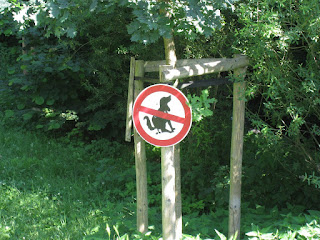
Tuesday last week I visited Castle Marksburg and about seven other castles and towers in various states of ruination along the Middle Rhine. Barons of various degrees built all sort of fortifications along the Rhine to levy taxes on the river traffic and "sell protection." The Mafia was alive and well in medieval Germany.
Marksburg is really fantastic and in excellent condition. It was never captured or destroyed, the only castle in this area to remain so, and is now the headquarters and offices of the Deutsche Burgenvereinigung (German Castle Association). It's the ancestral home of the Count Katzenelnbogen, which for some reason means "Cat's Elbows". Visitors are advised to control their dogs.

We were given an excellent English tour by a German hunchback with a bundle of enormous iron keys. I'm not kidding.

The castle residents sported a variety of lung diseases. All the beds were deliberately too short, forcing you to sleep sitting up. If you fell over in the night, you risked drowning in your own phlegm.

This anatomically-correct coat of arms hangs just inside the main gate. I think the Landgraves of Hess were compensating for something.

The castle kitchen was very impressive. The meals for the great hall were prepared and arranged on these tables and then the entire table would be carried up the uneven stairs to the hungry guests. They could have passed the food bucket-brigade-style to the main hall, but they were too busy carrying that heavy table to stop and think about it.

I found this chastity belt in the armory. Guaranteed to prevent damnation or your virginity back!

Back in the day, the castle's walls were plastered and painted, inside and out. This was common to every castle, but our movies filmed in castle ruins make most people think the plaster is unusual. The German Castle Association is restoring the plaster and paint according to contemporary color sketches.

After Marksburg, we drove through a few small towns on the Rhine. It was just like what you've seen in postcards and tourism movies: beautifully-constructed traditional-style houses with old churches and fragments of the ancient town walls scattered between. The Rhine has very few bridges, so most people cross with ferries. The ferry advertisements, typically German, sound more like warnings. My favorite: "Without this ferry, you don't stand a chance!"

This is wine country and vineyards abound. Germany is at approximately a 45-degree latitude, so most of the grapevines are planted on a 45-degree slope to receive maximum direct sunlight throughout the day.

There's a cat-and-mouse pun started by, or related to, Count "Cat's Elbows" Katzenelnbogen that runs up and down this valley. This is Burg Maus, the "Mouse Castle". There's "Mouse Tower" further downstream.

The impressive Burg Rheinfels, the Rock of the Rhine.

Here's Burg Gutenfels, Castle "Good Rock". The origional owners were pirates of a sort, levying heavy taxes on the river traffic. It's a hotel now, so they're maintaining the tradition of extorting passersby.

The nobles of Burg Gutenfels built this interesting tower on a small island in the middle of the Rhine. It's blatantly intended for levying taxes on passing barges, and sinking those who don't feel spendy. The Germans recaptured it from the Spanish in 1504 when a small girl showed the German forces a way to sneek up on the castle undetected. The tennents of the modern Hotel Gutenfels wish she was still around so they could sneek out undetected.

Burg Sooneck.

No comments:
Post a Comment